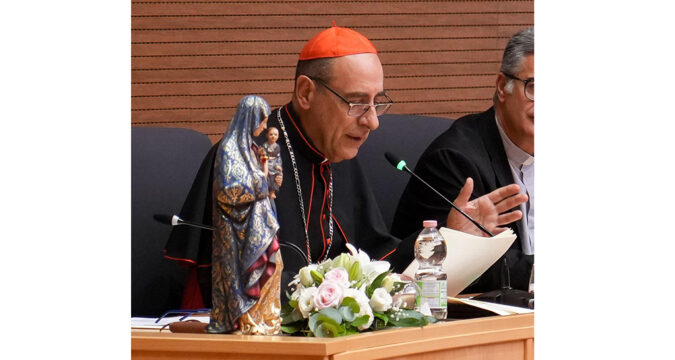
VATICAN (CNS): While praising devotion to Mary, the Dicastery for the Doctrine of the Faith firmly rejected moves to formally proclaim Mary as “co-redemptrix” or “co-mediatrix.”
In a doctrinal note, Mater Populi Fidelis, the dicastery stated that calling Mary co-redemptrix or co-redeemer risks overshadowing the exclusive role of Jesus Christ in salvation. It said Mary, “the first redeemed,” could not mediate the grace that she herself received.
However, it said, the title may be used when it does not cast doubt on “the unique mediation of Jesus Christ, true God and true man.”
Pope Leo XIV approved the text on October 7, and it was published on November 4.
Víctor Manuel Cardinal Fernández, prefect of the dicastery, presented the document during a conference at the Jesuit headquarters in Rome and said its teaching is now part of the Church’s “ordinary magisterium” and considered authoritative.
For more than 30 years, some Catholics, including some bishops, have asked for formal dogmatic declarations of Mary as co-redemptrix and co-mediatrix, the document’s introduction said. But Monsignor Armando Matteo, secretary of the dicastery’s doctrinal section, told the conference that the Vatican’s first study of the doctrinal implications of the titles goes all the way back to 1926.
The precise meaning of these titles [co-redemptrix and co-mediatrix] is not clear, and the doctrine contained in them is not mature
Pope Benedict XVI
The document said titles for Mary should reflect her motherly care and her role as the first and perfect disciple of Jesus, but must not cast doubt that Jesus is the sole redeemer and bestower of grace.
“Any gaze directed at her that distracts us from Christ or that places her on the same level as the Son of God would fall outside the dynamic proper to an authentically Marian faith,” the document said, because Mary always points to her son.
The titles co-redemptrix and co-mediatrix have been used in reference to Mary by theologians and even popes in the past millennium, the doctrinal dicastery noted, but without elaborating on the precise meaning and the extent to which those titles could describe Mary’s role in salvation history.
Pope St. John Paul II used “Co-redemptrix” for Mary on at least seven occasions the note said, but after consulting with Joseph Cardinal Ratzinger [later Pope Benedict XVI] in 1996, he did not issue a dogmatic declaration and stopped using the title.
Citing Scripture and tradition, the future Pope Benedict XVI said, “The precise meaning of these titles [co-redemptrix and co-mediatrix] is not clear, and the doctrine contained in them is not mature.”
Mary’s role in salvation history is unique: she accepted being the mother of Jesus, raised him, travelled with him, and stood by his cross
Pope Benedict said, “Everything comes from him—Christ—as the Letter to the Ephesians and the Letter to the Colossians, in particular, tell us; Mary, too, is everything that she is through Him. The word ‘Co-redemptrix’ would obscure this origin.”
Pope Francis, at a general audience in 2020, said that Jesus entrusted Mary to humanity as a mother, “not as a goddess, not as co-redemptrix,” adding that love motivated some people to call her co-redemptrix, but love often leads people to “exaggerate.”
The note said it is not appropriate to use “Co-redemptrix” to describe Mary’s cooperation in redemption, given her subordinate role to Christ.
The title, it said, “risks obscuring Christ’s unique salvific mediation and can therefore create confusion and an imbalance in the harmony of the truths of the Christian faith, for ‘there is salvation in no one else, for there is no other name under heaven given among men by which we must be saved’. “
The dicastery concluded, “When an expression requires many repeated explanations to prevent it from straying from a correct meaning, it does not serve the faith of the People of God and becomes unhelpful.”
The use of the title “co-mediatrix” is more complicated, the doctrinal note said, because the word “mediation” often is “understood simply as cooperation, assistance or intercession” and easily could apply to Mary without calling into question “the unique mediation of Jesus Christ, true God and true man.”
Mary’s role in salvation history is unique: she accepted being the mother of Jesus, raised him, travelled with him, and stood by his cross.
While Christ alone is the one mediator between God and humanity, he enables others to participate in his plan: all believers can, in some way, become cooperators with God and “mediators” for each other.
The doctrinal note said, “If this holds true for every believer—whose cooperation with Christ becomes increasingly fruitful to the extent that one allows oneself to be transformed by grace—how much more must it be affirmed of Mary in a unique and supreme way.”
The Church believes that those in heaven can pray and intercede for people still on earth and, “among those chosen and glorified with Christ, first and foremost is his Mother,” the note said. “Therefore, we can affirm that Mary has a unique collaboration in the saving work that Christ carries out in his Church. With this intercession, Mary can become for us a motherly sign of the Lord’s mercy.”








